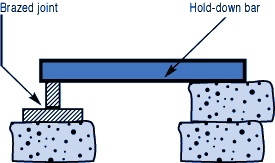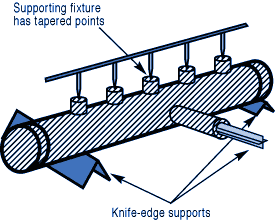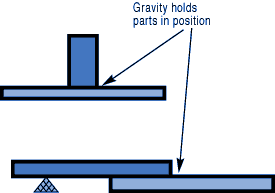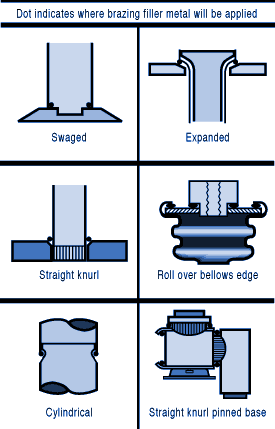钎焊基本原理
您遇到钎焊方面的问题吗?或需要我们推荐合适的钎焊产品吗?欢迎和我们联系!
鲁科斯钎焊材料(苏州)有限公司
中国 江苏省苏州市苏州工业园区星龙街428号苏春工业坊标准厂房8B
手 机:18862195523
Email:ABian@lucasmilhaupt.com WeChat:bxc615
手 机:13580355062
Email: KCheng@lucasmilhaupt.com
手 机:18660285329
Email:Lli@lucasmilhaupt.com
手 机:13512375105
Email:WWei@lucasmilhaupt.com
电话:15862440316
Email:Jxia@lucasmilhaupt.com
电 话:0512-62891510-215
Email:CFang@lucasmilhaupt.com

The parts of the assembly are cleaned and fluxed. Now you have to hold them inposition for brazing. Be sure they remain in correct alignment during the heatingand cooling cycles, so that capillary action can do its job. If the shape and weight of the parts permit, the simplest way to hold them together is by gravity. Or give gravity a helping hand by adding additional weight.
 If you have a number of assemblies to braze and their configuration is too complex for self-support or clamping, use a brazing support fixture. Design it for the least possible mass, and the least contact with the parts of the assembly.
If you have a number of assemblies to braze and their configuration is too complex for self-support or clamping, use a brazing support fixture. Design it for the least possible mass, and the least contact with the parts of the assembly.
(A cumbersome fixture that contacts the assembly broadly will conduct heat
away from the joint area.)
Use pinpoint and knife-edge design to reduce contact to the minimum.
Try to use materials in your fixture that are poor heat conductors, such as
stainless steel, Inconel or ceramics. Since these are poor conductors, they draw the least heat away from the joint.
 Choose materials with compatible expansion rates so you won’t get alterations in assembly alignment during the heating cycle.
Choose materials with compatible expansion rates so you won’t get alterations in assembly alignment during the heating cycle.
If you’re planning to braze hundreds of identical assemblies, think in terms of designing the parts themselves for self-support during the brazing process. At the initial planning stage, design mechanical devices that will accomplish this purpose, and that can be incorporated in the fabricating operation. Typical devices include crimping, interlocking seams, swaging, peening, riveting, pinning, dimpling or knurling.
Sharp corners should be minimized in mechanically held assemblies; corners can impede capillary action and should be slightly rounded to aid the flow of filler metal. A simple mechanical holding device is the best, since its only function is to hold the parts together while the permanent joint is made by brazing.

Fixture Facts
A fixture is built to cradle, hold or secure an assembly to be joined. Proper fixtures should meet these criteria:
>> Allow easy insertion of assembly components and easy removal of the brazed assembly
>> Support assembly components to permit expansion and contraction during heating and cooling
>> Support the assembly at points away from the heat zone (preventing the fixture from becoming a heat sink)
>> Permit the flame to be directed around the entire joint area, so the alloy can flow throughout the joint
>> Use gravity to assist capillary action
>> Maintain alignment and dimensional stability until the alloy solidifies
>> Be sufficiently flexible to accommodate other similar assemblies
Better Joint Design
An axiom of metal joining is that proper joint design is the path to efficient fixturing. Brazing experts at Lucas Milhaupt offer these tips for improving your joint design:
>> Make component pieces of the assembly self locating, so the fixture only supports and cradles the components.
>> Allow space for the filler metal to flow and for flux to be forced out of the joint.
Example Problem: Where a tube enters a fitting or casting, some manufacturers use a press fit to keep externally applied alloy from reaching the bottom of the joint, where it might plug a hole in the fitting. Unfortunately, molten flux reaches the bottom of the blind hole and is trapped there, as alloy melts and tries to enter the joint. The alloy cannot displace the flux, so heavy flux inclusions andpoor joint quality result.
Example Solution: Use a slip fit and a buried preform in the hole. The alloy is induced by heat to flow to the top of the joint, pushing the flux out. This leaves the hole open and results in a sound joint. Take into account the expansion and contraction characteristics of the metals being joined. If possible, design the joint so the higher-expansion material is the outer member of the joint. (It will expand more than the inner member, providing clearance where the filler metal will flow.)
Silver brazing is a cost-effective method for joining metals, especially when joints are designed for maximum brazing efficiency and fixtures are designed as described. Many products manufactured today could be redesigned for brazing to reduce manufacturing costs. Even though silver is expensive, it represents a small percentage of total assembly costs.
Fixturing Tips
Lucas Milhaupt engineers offer these ideas for improving manufacturing efficiency with fixturing:
>> Construct fixtures from 300-series, non-magnetic stainless steel for better corrosion resistance and dimensional stability (other ideas include Inconel and some ceramics).
>> When fixturing for furnace brazing, hold the mass of the fixture to aminimum. (Payoff is dependent on lb/hr through the furnace; increased weight = reduced fuel efficiency.)
>> When fixturing for induction heating, keep fixtures away from the work coil, so they will not act as heat sinks or interfere with the magnetic field.
>> Avoid use of springs for bringing parts back to dimensional alignment. If they are required, keep them out of the heat zone, so they will not be
affected by flux residue or oxidation.
Fixture design is a key factor in achieving quality flame-brazed or soldered joints. In addition, proper joint design is the path to efficient fixturing.
Combining improvements to both these areas can result in better-quality joints, increase operating efficiency and reduce costs.
